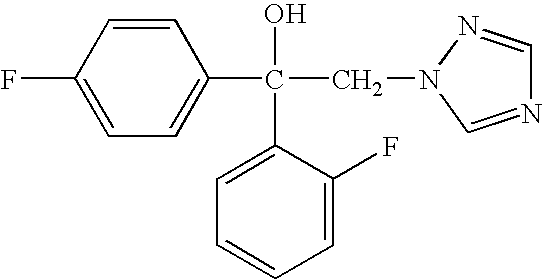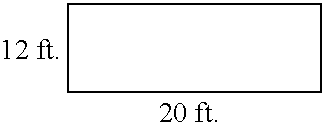Method of protecting a soybean plant with flutriafol
a technology of flutriafol and soybean plant, which is applied in the direction of biocide, plant growth regulator, animal husbandry, etc., can solve the problems of plant premature defoliation, rust disease, and a significant threat to soybean crops in the united states, so as to achieve the effect of prolonging the control of foliar diseases and not causing phytotoxicity
- Summary
- Abstract
- Description
- Claims
- Application Information
AI Technical Summary
Benefits of technology
Problems solved by technology
Method used
Image
Examples
example 1
[0070] The following experiments demonstrate the systemic activity of flutriafol used as a seed- or soil-dressing, to combat Asian Rust (Phakopsora pachyrhizi) in Soy Beans.
[0071] Soy bean seed was treated with a range of flutriafol rates, as presented in Table 1 below (right-hand side). Additionally, flutriafol was applied directly to the soil, at the rates described below (left-hand side). Three replicates were done per treatment. At the third trifoliate stage, seedlings where inoculated with rust spores on the ad- and ab-axial surfaces of the third trifoliate.
[0072] Following treatments and inoculations, the inoculated plants were transferred to a climate chamber, watered as necessary and evaluated for the incidence of Asian Rust. The average of the recorded incidence of disease (%) on the third trifoliate is presented below. An untreated control is also provided as comparative data.
TABLE 1Dose, soilDose, seedapplicationTreatmenttreatment(g ai / Ha)SoilSeed(ppm)UTC8053UTC373473...
example 2
[0074] A trial in Brazil at Formoso do Araguaia examined the rust control from nine rates of flutriafol applied as a 1.5% granule in a rate range of 4 to 40 kg formulated product per hectare (60 to 600 g flutriafol active ingredient per hectare), three rates of Vincit 2.5% powder seed dressing at 150 to 250 g formulated product per 100 kg seed (2.25 to 3.75 g flutriafol active ingredient per 100 kg seed) and four rates of Vincit 5% SC suspension concentrate seed dressing at 50 to 150 g formulation per 100 kg seed (1.5 to 4.5 g flutriafol active ingredient per 100 kg seed).
[0075] These treatments were compared with an untreated and a commercial standard treatment of Derosal Plus, which is a mixture of carbendazim plus thiram in a suspension concentrate formulation applied to seed at a rate of 200 ml formulation per 100 kg seed (30 g thiram plus 70 g carbendazim) per 100 kg seed. Both the untreated sample and the Derosal Plus treatment are provided below as comparative data.
[0076] S...
example 3
[0081] A greenhouse experiment was performed to demonstrate the systemic activity of Flutriafol used as a soil-dressing. The following experiments demonstrate the systemic activity of Flutriafol used as a seed- or soil-dressing, to combat Asian Rust in Soy Beans.
[0082] Soya seed was treated with a range of flutriafol rates, as presented in Table 3 below (right-hand side). Additionally, flutriafol was applied directly to the soil, at the rates described below (left-hand side). Three replicates where made per treatment. At the third trifoliate stage, seedlings where inoculated with rust spores on the ad- and ab-axial surfaces of the third trifoliate.
[0083] Following treatments and inoculations, the inoculated plants where transferred to a climate chamber, watered as necessary and evaluated for the incidence of Asian Rust. The average of the recorded incidence of disease on the third trifoliate is presented below.
TABLE 3TreatmentDoseSoilSeedDose(g ai / Ha)(28DPI)(21DPI)(ppm)UTC3949UT...
PUM
| Property | Measurement | Unit |
|---|---|---|
| lengths | aaaaa | aaaaa |
| length | aaaaa | aaaaa |
| width | aaaaa | aaaaa |
Abstract
Description
Claims
Application Information
 Login to View More
Login to View More - R&D
- Intellectual Property
- Life Sciences
- Materials
- Tech Scout
- Unparalleled Data Quality
- Higher Quality Content
- 60% Fewer Hallucinations
Browse by: Latest US Patents, China's latest patents, Technical Efficacy Thesaurus, Application Domain, Technology Topic, Popular Technical Reports.
© 2025 PatSnap. All rights reserved.Legal|Privacy policy|Modern Slavery Act Transparency Statement|Sitemap|About US| Contact US: help@patsnap.com


